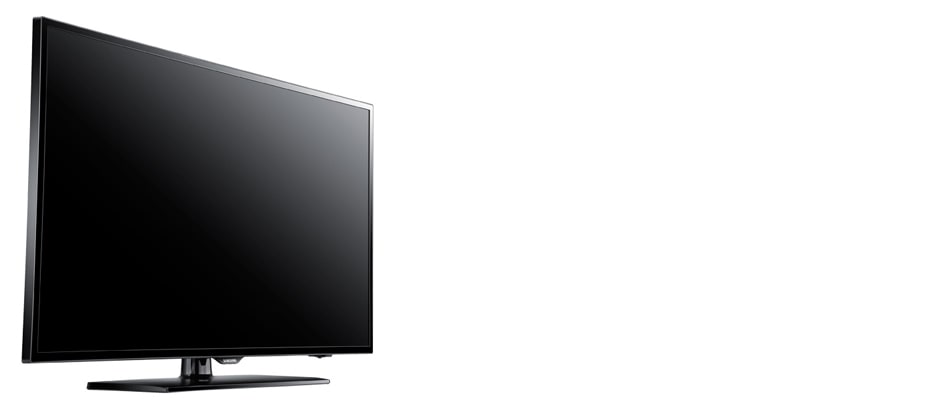Pros
Cons
Introduction
Overall Design
{{section_header}}{{section.name}}{{/section_header}}
The UN40EH6000 is the first 2012 TV that we’ve reviewed, and we hope that Samsung continues to pursue this design throughout the year. The combination of the screen and thin bezel make for an elegant and monolithic appearance from the front, while the side view strikes a subtle median between thin and thick—like the perfect bowl of porridge, the UN40EH6000 looks “just right.” It’s hard to find anything but praise for this model’s appearance.
Front
{{section_header}}{{section.name}}{{/section_header}}

Back
{{section_header}}{{section.name}}{{/section_header}}

Sides
{{section_header}}{{section.name}}{{/section_header}}

Stand/Mount
{{section_header}}{{section.name}}{{/section_header}}
The stand, like the rest of the TV, is fairly understated in its appearance—I wouldn’t say it's necessarily unremarkable, but it gets the job done, and just. The base is heavy, perhaps slightly heavier than it needs to be, but better to be safe than sorry. The one complaint we could field was that the stand allows for no adjustment or swiveling of the panel, and that's a pretty big complaint. Not only does this glaring omission of a now standard feature limit the user's ability to easily access the TV's back and side ports, but it means that if you want to watch the TV from multiple angles you have to heft and shift the entire product to do so. We're not sure what Samsung was thinking when they made the decision to have a static stand.

Controls
{{section_header}}{{section.name}}{{/section_header}}
The UN40EH6000's controls are located on the underside of the bezel, just beside the IR sensor, via a slightly protruding platform that features a single axial button (see the picture for clarification). Pressing the button turns the TV on and off; right and left presses control speaker volume (increase and decrease, respectively), while the up and down presses change channels. This feature seems to be shared by the EH5000 and EH6000 models, and in our opinion is a swell idea. It's easy to memorize, easy to use, and easy to find in the dark, especially considering you only have one button to find (as opposed to a multiple button layout) and it gives tactile feedback (as opposed to a touch-sensor layout). While you can't select an input source or access the menu, it's enough to get the TV shining so you can find the remote in an unlit space.

Remote Control
{{section_header}}{{section.name}}{{/section_header}}
The remote control included with the Samsung UN40EH6000 is the direct descendant of the remote that shipped with many of Samsung’s 2011 models, and we personally feel that last year's model was better. It was a little big bigger, fitting into the average hand more comfortably, and its arrow buttons (for menu navigation) were larger than those found on the 2012 variant. We consider it a mishap that Samsung deducted from their size and made them harder to find without looking down at the remote. Fortunately, the overall shape and button layout has gone unchanged, and their standard remotes are still equipped with a backlight (always a good idea).

In the Box
{{section_header}}{{section.name}}{{/section_header}}
The Samsung UN40EH6000 ships with the remote, 2 AAA batteries, 8 identical screws, the stand and mount, a quick-start guide, and Samsung’s warranty information.
Black Level
{{section_header}}{{section.name}}{{/section_header}}
The Samsung UN40EH6000 showed an impressive black level for an LCD screen. We did notice that the screen auto dims when it displays a completely black picture, which can create an artificially dark black level, and therefore a falsified contrast ratio. However, we come fully prepared, and measure our deepest black level by recording the luminance at the center of the screen with 20% white frame so that the backlights are engaged during this reading. Showing black values at 0.05 cd/m2 makes for a starkly well rendered picture. More on how we test black level.
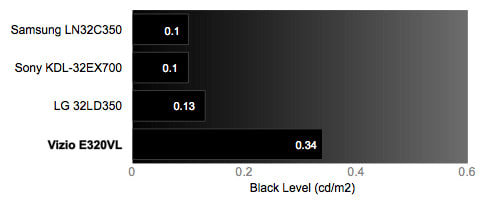
Peak Brightness
{{section_header}}{{section.name}}{{/section_header}}
Though we recorded a deep black level, the peak brightness suffered a little. The brightest whites will only be displayed at 230 cd/m2 . This value is within our acceptable range for viewing in most any lighting situation, but it is not the brightest toddler in kindergarten. More on how we test peak brightness.
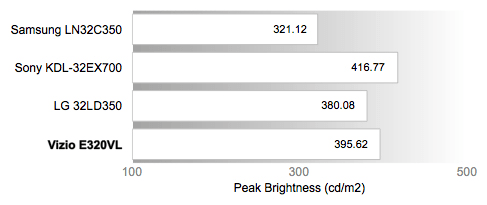
Contrast
{{section_header}}{{section.name}}{{/section_header}}
Even without a stunning peak brightness, the {{product.name}} has a great contrast ratio of over 4500:1. This is a measure of the range of possible light and dark values available to a TV. The more values of light and dark used, the more realistic the picture will look. Contrast ratio is a measure of the possible values, the grayscale gamma chart at the bottom of this page shows us how well this range is used. More on how we test contrast.

Tunnel Contrast
{{section_header}}{{section.name}}{{/section_header}}
There is a very slight downward trend to this graph, but the up and down movement is so slight as to be insignificant. The important point is the drop off right at the end of the chart where the screen becomes 100% black. We saw the backlights turn off when the screen showed a completely black picture, but there was no noticeable dimming with any other displayed pictures. This will make for a solidly black screen during fade outs, but it will not affect the picture when watching any type of content even with small amounts of white on the screen, like during credit sequences. More on how we test tunnel contrast.
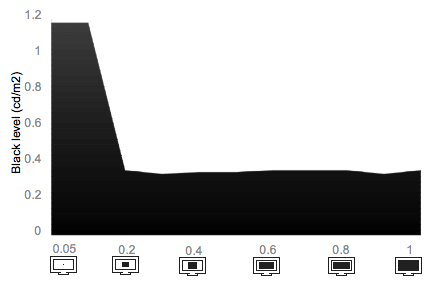
White Falloff
{{section_header}}{{section.name}}{{/section_header}}
The straight horizontal line in the chart below shows us that the {{product.name}} does not brighten or dim the peak brightness depending on what is shown on the screen. A consistent peak brightness is maintained regardless of the imagery on screen. More on how we test white falloff.
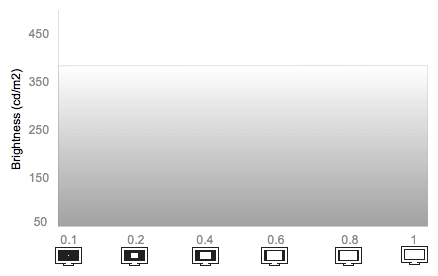
Uniformity
Greyscale Gamma
{{section_header}}{{section.name}}{{/section_header}}
This grayscale graph shows above average detail in gray values from darkest to brightest. The slope of the graph, 2.65, is a little outside the ideal range of 2.15, but the general smoothness of the line shows us that there is a unique gray value produced for every signal input value.
The slope being too steep means that the gray values increase in brightness too quickly. As a result, there transitions from dark to light will not be as imperceptibly smooth as they could be, but this is not an egregious error.
The smoothness producing unique gray values means that, given any value from dark to light, the {{product.name}} will output a corresponding and unique gray value. When we said that contrast ratio is a measure of the possible range of values, and that the grayscale graph is a demonstration of the application of this range, the smoothness of the graph shows that almost the entire contrast ratio is being employed to create a stark picture.
The few humps at the beginning of the chart show just the opposite. The peaks and valleys indicate values that were improperly reproduced as either too bright, too dim, or completely incorrect. These inconsistencies are minor however, and relegated to the darkest end of the spectrum. When we looked at a grayscale gradient from darkest to brightest, we did not see major inconsistencies anywhere. In fact, we were impressed with how smooth the gradient appeared. Yet again, well done Samsung. More on how we test greyscale gamma.
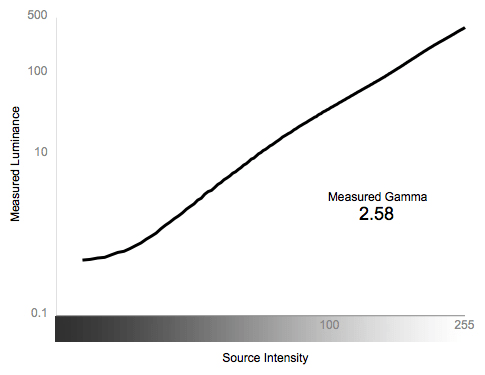
Color Temperature
{{section_header}}{{section.name}}{{/section_header}}
The {{product.name}} showed almost perfect color temperature accuracy, with what seems to be a cooling error right at the darkest end of the spectrum. This is a slight error and the picture will be so dark that you will probably not notice a slight blue tint. More on how we test color temperature.

RGB Curves
{{section_header}}{{section.name}}{{/section_header}}
These color curves are close to ideal, but also show some heavy errors. We saw problems immediately when we calibrated. The Color setting in the picture settings menu did not adjust the contrast of the colors, as these functions typically do. We saw that the brightest blue and red values were oversaturated, thus unable to be rendered with detail. We adjusted the Color setting to remedy this, and found that it only made the colors more gray instead of adjusting the contrast of color brightness. Such an adjustment would increase (or decrease) the color detail available. Without the proper calibration options, the blue and red values were lost the moment this TV was made.
You can see that both the blue and red lines peak early. This peaking represents the inability to get any brighter after a certain point, thus losing detail in the brightest inputs. You can also see that the blue line is saggy, especially at the leftmost side of the chart, where it is almost horizontal. A horizontal line would indicate no difference from one value to another. What we see here is very little detail distinction in blue values, followed by an overly bright increase in detail, until the blues are too bright.
The green values seem to be the best in detail distinction. You can see the smooth, even curve of the line reaching from 0 to 100% signal brightness without any flat lines or peaking. This shows that the green values transition evenly, from dark to bright, without a problem. More on how we test RGB curves.

The strips of color shown here are reproductions of the graphs above, using the produced luminance for a given input signal, with 256 values of each of the primary colors. You can see how they match up to what would be the ideal response.
Motion Performance
{{section_header}}{{section.name}}{{/section_header}}
There are two motion processing modes on the Samsung UN40EH6000, Auto Motion Plus, and LED Motion Plus. Neither of these functions were commendable in any fashion. The Auto Motion Plus feature suffered from the many problems we frequently discuss, regarding the Soap Opera Effect. While causing problems for film based content, it also showed significant errors in our motion tests. The smoothness of the motion was excellent, retaining very fine details while in motion, but you would hardly notice this detail for all of the artifacts introduced to the picture.
Artifacts are any part of the picture that are not supposed to be there; images not inherent in the input signal that are displayed on the screen. At the start of every motion was some crazy pixel freakout, where chunks of pixel clusters showed some entirely opposite frame. We wanted to see if this jumbling of the picture was obvious when watching content, and we saw it there too. The noise we saw in our motion tests carried over into actual content, though it was less noticeable. Once we caught it though, it was hard not to see it in just about every moving object from people waving their hands to cars rolling down the street. We turned the Auto Motion Plus function off, and it corrected the pixel freak out, but the slanting and jagged edges increased.
The LED Motion Plus function claims to make for smoother motion in fast moving scenes. What we saw instead was just a dimmer screen. We tested this actually, and found that this function dropped the peak brightness by about 100 cd/m2 . That is almost half of the total brightness recorded on the screen, which would drastically reduce the contrast ratio. Further, we couldn't see any actual adjustment in the motion processing. Our best guess is that, by making the screen dimmer, it will be harder to notice all the damn artifacts. More on how we test motion performance.
3:2 Pulldown & 24fps
{{section_header}}{{section.name}}{{/section_header}}
Standard film content is shot at 24fps (frames per second). 3:2 Pulldown refers to how well a television scales its native frame and refresh rates to match film-based content. The UN40EH6000 has a refresh rate of 120Hz, twice the refresh rate of standard television screens (60Hz), which means that natural film content must be imbued with numerous extra frames per second in order to maintain its original appearance. The Samsung UN40EH6000 suffered a lot of flickering and jittering when put up against our 24fps SMPTe pattern, but otherwise the image maintained an impressive smoothness. The UN40EH6000's Film Mode did little to correct these difficulties, but was definitely noticeable during moving, video-based content; in fact the UN40EH6000 scored higher than average during this test--with or without Film Mode--with very little noticeable frame rate correction or lagging content. More on how we test 3:2 pulldown and 24fps.
Resolution Scaling
{{section_header}}{{section.name}}{{/section_header}}
The Samsung UN40EH6000 is a native 1080p television, and naturally shows no problems with 1080p content. But since most broadcast content is not yet processed at 1080p quality, we tested how well the UN40EH6000 maintained its resolution at 720p and 480p, the broadcast resolution for high-definition and standard-definition content. More on how we test resolution scaling.
480p
The Samsung UN40EH6000 tested at 3% vertical overscan and 2% horizontal overscan, with screen settings such as 16:9 or Screen Fit doing nothing to fix this. There was a little banding during our moire interference test, but overall the UN40EH6000 maintained top legibility and resolution for 480p content. To achieve the best picture (with 0% overscan!), it is recommended that you set the screen to 4:3 aspect ratio, as this is the natural setting for all 480p content.
720p
720p resolution is where the Samsung UN40EH6000 really tripped over its cables. While initially eschewing some overscan problems, we discovered that changing the resolution from native 1080p to 720p also changed the Screen setting from "Screen Fit" to "16:9". Changing back to Screen Fit fixed the overscan, but nothing could be done in the way of pixel banding. The 720p setting is much better than some HDTVs we've seen, but the Samsung UN40EH6000's overall score was dropped in this area due to some of the worst pixel reproduction (short of total illegibility) possible. Despite this, the 720p content resolution was as good as its 1080p resolution, and text legibility was (surprisingly) even better.
1080p
1080p is the native resolution of the Samsung UN40EH6000, and thus its score in this area is just shy of perfection. There was (obviously) no overscan, no pixel banding, and perfect resolution. The only complaint we had was that text below a 9-point font was slightly less legible than we'd have liked.
Formats
{{section_header}}{{section.name}}{{/section_header}}
The {{product.name}} is native 1080p and stands up to all NTSC formats.
Viewing Angle
{{section_header}}{{section.name}}{{/section_header}}
It's been well established that most LCD screens fall well short on maximum viewing angle when compared to Plasmas, but amongst other liquid crystal display HDTVs, the {{product.name}} did a better than average (see below). Interestingly, the {{product.name}} had an increase in contrast between a 0-10% angle from the center of the screen (due in part to a shift in its deepest black level), but contrast takes a sharp decline anywhere beyond an approximately 31% off-center viewing angle, giving a 61% total viewing angle--not too shabby for an LCD.

Reflectance
{{section_header}}{{section.name}}{{/section_header}}
The {{product.name}} did not do so well during our reflectance test. During this test, we shine a bright LED light against the screen (during movie content) to see how well the LCD refracts, blurs, or otherwise attempts to diffuse the light into a more subtle/less annoying pattern. The light reflected in an almost perfect mirror (bad news for a well-lit room), with almost no observable diffusion. In fact, we could see the mirrored image of the LED bulbs in nigh perfect detail. The one plus for the {{product.name}} is that, at least, it did not spread the LED glare over more of the screen than it needed to.
Video Processing
{{section_header}}{{section.name}}{{/section_header}}
The {{product.name}} has 7 video processing modes.
Calibration
{{section_header}}{{section.name}}{{/section_header}}
As usual, the {{product.name}} standard settings were in need of some adjustment, but very little by comparison to other LCDs. As you can see from the table below, our settings varied only slightly from the {{product.name}} originals. We did find that no single color setting was perfect for all colors involved (green was especially tricky, either oversaturated or diminished into a sea-foam color), but 41 was the best option for the entire RGB curve.
{{ attachments(511e730c31da63607e0003c8)
{{ attachments(50fc3e94bd0286d5550af2b9)
All of our calibration is done in conjunction with the DisplayMate software.
Video Modes
{{section_header}}{{section.name}}{{/section_header}}
The {{product.name}} has three video modes: Dynamic, Standard, and Movie. They are fairly self explanatory, and more or less do what they purport.
{{ attachments(511e73268021d5fed70004eb)
Connectivity
{{section_header}}{{section.name}}{{/section_header}}
The {{product.name}} has three side ports: HDMI 1, HDMI 2, and USB playback.

The {{product.name}} has a small recessed space on the right side of the back (just beyond its side ports) for a shared component/composite set, EX-LINK out, analog audio out, digital audio out, and the antenna/cable in.
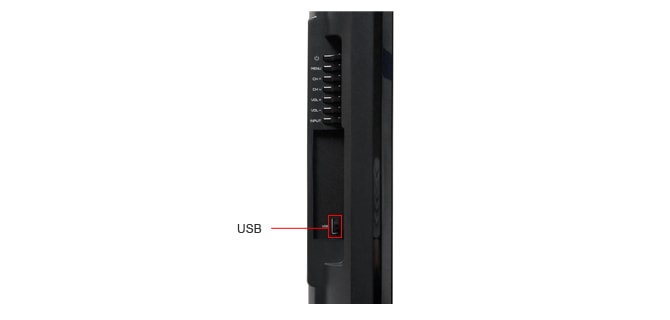
{{ attachments(511e9cbb4671233e0c000090)
Placement
{{section_header}}{{section.name}}{{/section_header}}
The simple ports on the {{product.name}} are well presented, with more commonly used ports (HDMI, USB) located on the right side of the TV at roughly the same height as the recessed port area in back. The audio-out ports (for headphones or surround sound) and cable/antenna port are located on the back of the TV, likely because these ports will need access rarely, if ever, beyond initial set-up. This smart port placement is a plus for the {{product.name}}, because this baby doesn't swivel an inch.
Other Models in the UNxxEH6000 Series
For more information on other models in this series, check our Series Comparison Page.
{{ attachments(511e9f6ce09009ca710000a1)
Audio Quality
{{section_header}}{{section.name}}{{/section_header}}
The Samsung UN40EH6000 maintains a now long-standing tradition of “I guess it’ll do” audio quality amongst otherwise stellar TVs. But that is typically what you get with embedded 10w speakers: acceptable and over-emphasized middle range, with the high-end trebles and low-end basses taking a hit to clarity. Not the worst speakers we’ve ever heard, but not the best. The only sensible complaint would be directed towards the UN40EH6000’s surround sound mode: if it actually does anything, we’ve yet to hear it.
Menu Interface
{{section_header}}{{section.name}}{{/section_header}}
Following the tradition set forth in their 2011 models, the UN40EH6000’s menu system is simple, all-inclusive, and easy to navigate. Despite the captions provided to explain the function of each menu widget, the menus themselves are streamlined and arranged in such a way as to render the descriptive caption less a necessity and more akin to icing on the cake. Between the Menu, Return, Exit, and arrow navigational buttons, you know all you need to know.

One drawback to the UN40EH6000's menu is that some viewing and lighting options are grayed out and only accessible within certain TV modes, but you've no way of discovering this without a little experimentation. On the plus side, the menu load times (compared to Samsung's 2011 models) are noticeably faster.

Instruction Manual
{{section_header}}{{section.name}}{{/section_header}}
The inclusion of a detailed instruction manual with any semi-complex electronic equipment is not just a good idea—it’s often necessary. Considering the shortcomings of Samsung’s 2011 e-Manuals, we would have thought their 2012 TVs would be shipping with full, printed manuals to the benefit of consumers everywhere. Alas, the UN40EH6000 has only a small pamphlet detailing stand assembly and a Quick-Start guide to getcha’ channel surfing ASAP. Perhaps the UN40EH6000 is simply too new to have a PDF manual or a real paper one, but it sure feels like Samsung could take the time to do one or the other.

A manual for so many TV models, they have to be further categorized by type.
Local Media Playback
{{section_header}}{{section.name}}{{/section_header}}
The single USB port on the {{product.name}} is located on the right side, evenly spaced from its two HDMI ports. It is easy to access and use, and the menus are simple and straightforward.
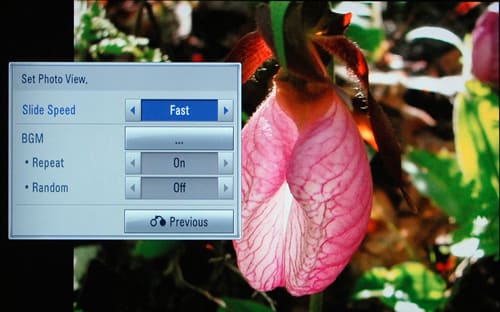
The Samsung UN40EH6000 plays back photos, music, and video clips from a USB drive. There is a long list of supported file formats in the paper manual that comes with this model which should help discern the use of this port.
Like previous Samsung models, photo playback includes some degree of customization in picture/music selection and playlist editing.
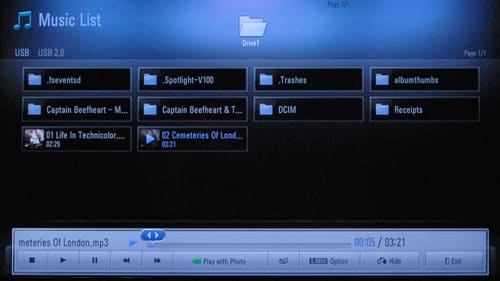
Power Consumption
{{section_header}}{{section.name}}{{/section_header}}
The {{product.name}} is not the cheapest 40-inch we've ever seen, but it's also not the most expensive. With the backlight at 16 (standard), the {{product.name}} costs about $13.86 a year. Maxed out at 20, that price gets bumped up to $15.95.
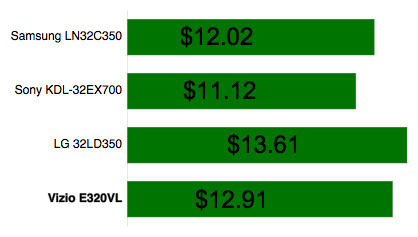
Value Comparison
{{section_header}}{{section.name}}{{/section_header}}
The Samsung UN40D6000 is a fine 2011 TV for its $1099 price tag, but considering the 2012 UN40EH6000 retails for about $800 and is comparably similar or superior in color, sound, and features, we might have a tough time suggesting the D6000 in lieu of the {{product.name}}.
Blacks & Whites
{{section_header}}{{section.name}}{{/section_header}}
The {{product.name}} scored higher than the D6000 in black level, comparably in peak brightness, and had a better contrast ratio at the end of the day. Naturally we would expect some level of progress between a 2011 Samsung and a 2012 Samsung, and the {{product.name}} looks to have the advantage, if only slightly.

Color Accuracy
{{section_header}}{{section.name}}{{/section_header}}
The {{product.name}} scored better overall in color temperature than its counterpart from last year, with an only slightly lower score in RGB curve and color gamut. These two are very similar, but color alone isn't enough to justify the price increase of the D6000.
Motion
{{section_header}}{{section.name}}{{/section_header}}
The biggest drawback to the {{product.name}}'s motion performance would have to be its artifacting issues during the 3:2 pulldown and 24fps tests. It performed better than the D6000 in overall sustained smoothness, as well as resolution scaling, but with such an atrocious issue with artifacts, it's hard to definitively recommend one TV over the other.
Viewing Effects
{{section_header}}{{section.name}}{{/section_header}}
The {{product.name}} scored better than most LCDs in overall viewing angle, and certainly trounced the competition we selected for it. The only drawback here is that the {{product.name}} has a pretty serious reflectance problem.
Connectivity
{{section_header}}{{section.name}}{{/section_header}}
The {{product.name}} falls well short of the connectivity options of the D6000, which has, among other options, a VGA connection, built in wi-fi, an ethernet port, 3 USB ports (including one specifically for HDD), and separate component/composite IN adapter (rather than the shared set-up of the {{product.name}}). If simplicity or minimalism is your goal, the {{product.name}} wins the race, but it is by far less flexible than the D6000 (which explains their difference in price).
Value Comparison
{{section_header}}{{section.name}}{{/section_header}}
The 2012 {{product.name}} costs a couple hundred dollars more than the 2011 Toshiba 40E210U, but a look at its superior scores in black level, color performance, and--subjectively--its elegant and tasteful aesthetic more than justify this difference.
Blacks & Whites
{{section_header}}{{section.name}}{{/section_header}}
The Toshiba 40E210U lacks the deep black level of the {{product.name}}, but its contrast ratio is saved by the absolutely blinding peak brightness it maintains when compared to similarly priced LED LCD televisions. The {{product.name}} outperformed the Toshiba 40E210U in greyscale gamma, but their overall differences are slight.

Color Accuracy
{{section_header}}{{section.name}}{{/section_header}}
The {{product.name}} wins hands down in color temperature over the Toshiba 40E210U, while performing slightly worse in color curves, though not so terrible as to fell its reliability in color issues. With an improved color gamut over the Toshiba, the {{product.name}} maintains its value.
Motion
{{section_header}}{{section.name}}{{/section_header}}
The {{product.name}} performed just slightly over the Toshiba 40E210U in smoothness and resolution scaling (and don't get us wrong, those are important), but its artifacting issues were enough to make it tough to suggest the {{product.name}} based on motion alone.
Viewing Effects
{{section_header}}{{section.name}}{{/section_header}}
Again, the {{product.name}} is the best in show when viewing angle is involved. We'd recommend this 2012 newcomer even more if it didn't deal so terribly with reflectance.
Connectivity
{{section_header}}{{section.name}}{{/section_header}}
The {{product.name}}'s limited connectivity options again put it in second place, with even Toshiba's entry level 40E210U boasting a VGA connection, split composite and component AV in, and DLNA possibility. Considering the Toshiba's connectivity options are considered "sparse" by modern HDTV standards, we can't help but question Samsung's choice for the UN40EH6000's ports.
Value Comparison
{{section_header}}{{section.name}}{{/section_header}}
The {{product.name}} is about $200 more expensive than the Dynex DX-46L261A12. Considering the 46-inch Dynex has the larger screen, this price difference could only be related to color and motion superiority. Or perhaps Samsung knows their name carries a certain weight in the world of high-definition televisions.
Blacks & Whites
{{section_header}}{{section.name}}{{/section_header}}
The {{product.name}} and the Dynex A12 both had a black level of 0.05 cd/m2: the Dynex's higher contrast ratio is thus due in part to its superior peak brightness. The {{product.name}} scored higher in greyscale and uniformity, however.

Color Accuracy
{{section_header}}{{section.name}}{{/section_header}}
The {{product.name}} scored higher in color temperature and RGB curve than the Dynex DX-46L261A12, and only marginally lower in color gamut. While the scores are close, the {{product.name}} did just a little better in overall color performance.
Motion
{{section_header}}{{section.name}}{{/section_header}}
We've said our peace about the terrible artifacting we tested on the {{product.name}}. On top of this, the Dynex model has higher scores in 3:2 pulldown and 24fps, and did only slightly worse than the {{product.name}} in resolution scaling. The {{product.name}} is once again burned by its artifacting problems.
Viewing Effects
{{section_header}}{{section.name}}{{/section_header}}
By now it's clear that the {{product.name}} is the uncontested champion of total viewing angle, but it was outperformed yet again in the reflectance round.
Connectivity
{{section_header}}{{section.name}}{{/section_header}}
The {{product.name}} and the Dynex DX-46L261A12 have very similar—and very limited—connectivity options, with the Dynex marginally pulling ahead due to its inclusion of a VGA port. We can't recommend either television based solely on connectivity.
Conclusion
This Samsung will probably be one of the only televisions in the 2012 line without smart controls, internet connectivity, or 3D images. The {{product.model}} ($779.99 MSRP) is a television you can take home, plug in, and enjoy right away. There are probably many consumers looking for a TV just like this, something stripped of all the doodads and geegaws with a great picture. It's easy on the eyes too.
The {{product.model}} showed some excellent black and white performance. The contrast ratio proved to be very strong, stemming from a superbly deep black level. We also saw excellent detail retention throughout this expansive range. If you like black and white movies, this will be one of the better televisions out there.
The color performance was good, but not great. We put a great deal of importance in color production, as we believe it gives the picture it's lifelike appearance. Specifically, the blue values were too bright, and the green values were too gray. You can see these errors when watching content, but it may not bother you wholly.
Overall, we think the {{product.name}} is a good buy, for a specific consumer. If you want a very basic television, there are other models out there for a couple hundred dollars less. The extra money gives you the backing of one of the best brand names in the business and a quality that is hard to match. We think that most television snobs will prefer a multi-function display that connects to the internet and turns on when you say "TV on!" However, if extra features seem unnecessary to you, but you won't settle for less than the best, this television will suit you just fine.
Model Series Comparison
There are four models of varying sizes in the UNxxEH6000 series.
{{section_header}}{{section.name}}{{/section_header}}
You can grab a television in the EH6000 series at 40, 46, 55, and 60 diagonal screen inches. Each of these displays are 1080p, with 10W speakers and only two HDMI ports. They lack advanced features like 3D imaging and internet connectivity, but produce a very accurate picture.
{{ attachments(511ea68b58253974b400013b)
Photo Gallery
{{photo_gallery "Front Tour Image", "Back Tour Image", "Sides Tour Image", "Stand Photo", "Controls Photo", "Remote Control Photo", "Connectivity Tour Image 1", "Connectivity Tour Image 2", "Connectivity Extra Photo", "Menu Main Photo", "Menu 2 Photo", "Internet Features 1 Photo", "Internet Features 2 Photo", "Internet Features 3 Photo", "Local Media Playback 1 Photo", "Local Media Playback 2 Photo"}}
Ratings & Specs
{{manufacturer_specs_table}}
Meet the tester
Christian Sherden is a valued contributor to the Reviewed.com family of sites.
Checking our work.
Our team is here to help you buy the best stuff and love what you own. Our writers, editors, and experts obsess over the products we cover to make sure you're confident and satisfied. Have a different opinion about something we recommend? Email us and we'll compare notes.
Shoot us an email